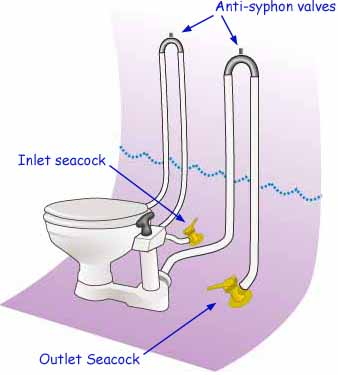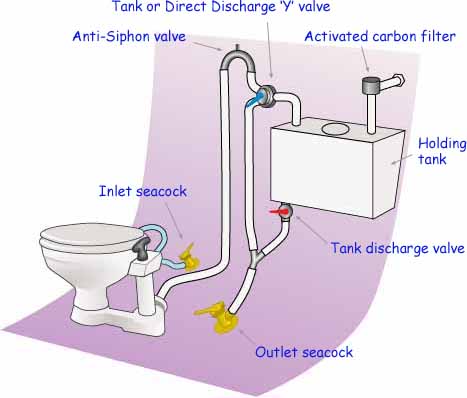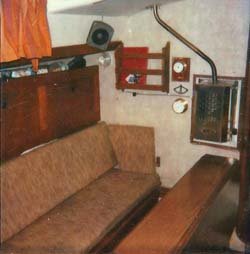- Home
- Choosing Accessories
- Parachute Sea Anchor
- Boat Toilet
The Ins and Outs of a Boat Toilet
My first ‘proper’ cruising yacht, a Nicholson 32, sported a Lavac boat toilet - and very efficient and reliable it was too. Pumping it created a vacuum which sucked out the er, contents. But to flush it, the lid had to be closed so that the vacuum could be created.
Once flushed, the vacuum remained for a while, firmly holding down the lid - which was a little irritating in the event of a queue…
Traditionally known as ‘the heads’ owing to the forward position normally allocated for it in old sailing vessels, pump operated sea toilets can be a little temperamental if not properly cared for.
They’ll either smell, leak (in which case they’ll definitely smell), the pump will block or the pipes will fur up. All of these unhappy events can be prevented by correct installation and regular maintenance – which we’ll return to later.
First though, we’ll take a look at the common types of boat toilet…
The Manually Pumped Sea Toilet
Artwork by Andrew Simpson
Your boat toilet’s malicious streak can come to a head (sorry) when it has been installed below the waterline, where it has the capability of sinking the boat if not fitted with siphon breaks on both inlet and outlet pipes.
Otherwise, for a toilet installed below the waterline, or one which becomes below the waterline when the boat is heeled, pumping flushing water in (and waste water out) will induce a siphon effect – flooding and eventually sinking your boat.
Anti-Siphon Valves are essential!
Remember to use Marine Sanitation Grade hose for all the discharge pipework to avoid permeation and resulting smells, and use double clips on all pipework connections to avoid leaks.
The 12v Electric Macerator Sea Toilet
These are intended for those with electrical power to spare and a reluctance to operate their right arm. Now everything is taken care of by the push of a button and your boat’s batteries.
One 12v pump sucks the flush water in and another delivers the waste either directly into the sea or to a holding tank.
Incorporated into the unit is a macerator which, much in the way of a culinary blender, reduces the waste and toilet paper to liquid form before pumping it either over the side or into a holding tank.
You have the choice of seawater or freshwater flush versions. If you choose the latter you'll need a watermaker of prodigious output.
A Portable/Permanent Marine Toilet System
These are entirely self-contained units. Installation is as simple as finding some secure place to put it.
The design of these units is simple; the waste falls by gravity into a detachable tank beneath the bowl which is periodically taken off the boat and emptied.
Typically they hold between 2 and 5 gallons of waste, and are very suitable for small sailboats or as an acceptable alternative to a holding tank installation.
How to Keep the Boat Toilet Working
We’ve all seen it happen. Man with length of flexible toilet hose trying grimly to beat it to death on the dock, chunks of unpleasant stuff flying in all directions.
The unpleasant stuff is a calcium deposit, the inevitable result of mixing uric acid with the salt and calcium carbonate present in saltwater.
This can be much reduced by making sure that we properly flush the toilet on every use.
It’s not enough to stop pumping just as soon as the toilet bowl is clear of our bodily waste products – you’ve got to keep going until the last of it exits the thru-hull fitting.
If you don’t, traces of it will be left in the pipe, the pump or the macerator where sooner or later it ruin your day.
So How Long Should I Keep Pumping?
For as long as it takes to clear the whole length of discharge hose and that of course depends on how long it is. The solution is simple…
- Put a few sheets of toilet paper in the pan, start pumping and count the strokes;
- Get another person to check when it emerges at the other end, add another half-a-dozen strokes or so and that’s how many times you must pump it on every use;
- Then click the switch across to ‘dry’ and pump a few more strokes to empty the pipes down to the water line and that’s it, job done!
Why Choose a Freshwater Flush Marine Toilet?
With all that seawater available it might seem a little strange to use your precious freshwater to flush your loo. However, as freshwater doesn't contain the minerals found in saltwater, the build-up of the calcium deposit described above just doesn't happen.
Another benefit is that the 'rotten-egg smell' (hydrogen sulfide gas) associated with saltwater toilets is eliminated too.
But - and it's a big but - just how do you ensure that no cross-contamination can occur between the freshwater that flushes your boat toilet and that in your freshwater tanks?
One skipper that I know avoids the risk completely by using his boats shower head to fill the toilet bowl while flushing. Others use the galley sink to divert freshwater from the sink's outlet to the toilet.
Both these solutions are fine for an occasional freshwater flush, but they're not very convenient for every flush.
But for a fully plumbed-in freshwater flush system that is entirely safe from cross-contamination? I'm not sure such a system exists, although Jabsco produce a Head Solenoid/Anti-Syphon Valve for their 12v electric toilets which goes a long way towards providing it.
Recent Articles
-
B&R Rig Explained: Hunter Sailboat Mast Design Pros & Cons
Jul 10, 25 11:08 AM
Demystify the B&R rig, a unique mast design found on many Hunter sailboats. Learn its advantages for cruisers, key features, and potential downsides. -
Hunter Sailboats: Cruising Comfort & Value for Recreational Sailors
Jul 10, 25 09:01 AM
Explore Hunter sailboats' history, design, and performance. Learn about popular models, construction, and what makes them a top choice for comfortable cruising. -
Albin Ballad Sailboat: Specs, Design, & Sailing Characteristics
Jul 09, 25 05:03 PM
Explore the Albin Ballad 30: detailed specs, design, sailing characteristics, and why this Swedish classic is a popular cruiser-racer.
















